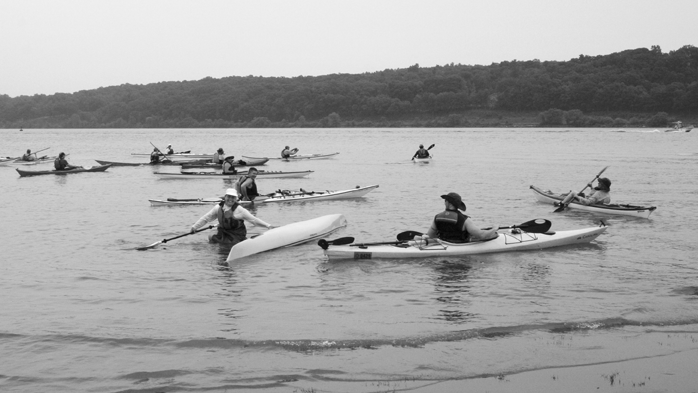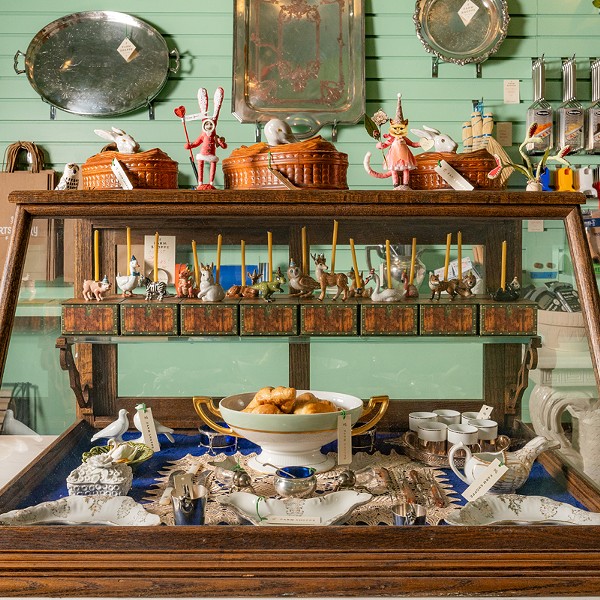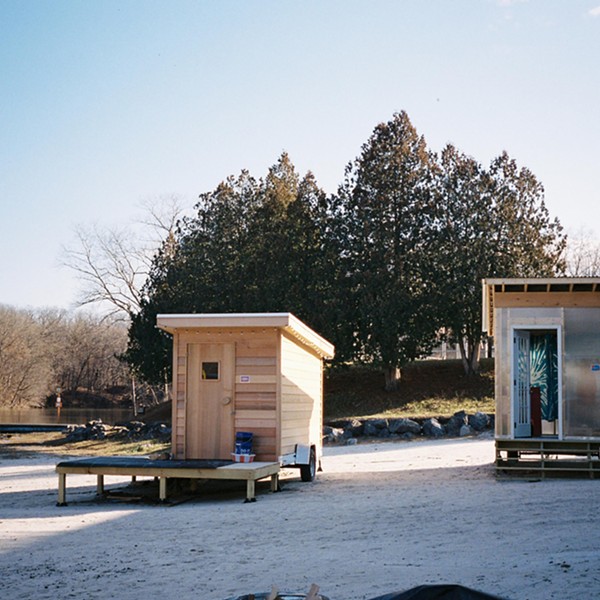The setting sun transforms the river vista as rays of pinks and yellow wind through billowing cumulus clouds. Orange streaks brighten the horizon, and all that’s missing is a gilt frame to permanently capture this quintessential Hudson River scene.
Water lapping against the rocks at Norrie Point creates a rhythmic beat, the cadence increasing as barges chug past and cigarette boats chase their wake. At times the water’s lull creates an eerie, quiet void, supplemented only by the buzz of conversation in the background.
Soon, mosquitoes will force people into the sanctuary of their hot, steamy, yet bugless tents. But for a few magical hours, we 30 people will revel in the peace we earned. After a day of kayaking 17 miles, crossing the shipping channel of the Hudson, and swimming in the shadows of the Esopus Lighthouse, our muscles are tired. Upon arriving at Norrie-Mills State Park in Staatsburg, showers do more than clean bodies—they refresh spirits. Our unified contentment comes from a day of successfully pushing physical limits; of the sun baking into our skin despite the SPF 45 sunscreen we all use; of sharing a huge communal feast of lasagna, salad, homemade venison sausage, and apple cobbler.
Folding chairs are brought in and playing cards are shuffled on picnic tables. People who were strangers a few days earlier share intimacies usually reserved for therapists as distant friends catch up on events from the past year. Some poke and prod their kayaks, fold and unfold various maps, and make the small talk that bridges the challenges of group dynamics.
Behind it all, the Hudson River is both the backdrop and the focus.
This is day five of a 10-day kayak trip from Albany to Manhattan, and the people camped out on this patch of green lawn on the edge of the river are slowly falling into routines.
It’s a rhythm and adventure that’s been repeated for the past six summers, as the Great Hudson River Paddle has become a signature summertime event.
A million miles away
Like the river itself, this outing has evolved. The trip’s early years—when it was the dream of a few wacky paddlers—ignored tide pulls, sleeping arrangements, and hygiene requirements. In 2001, the group went down the Hudson because kayaker Camilla Calhoun suggested it and, well, because it was there.
“My initial reaction was, ‘We’ll get involved because we don’t want anybody to get hurt,’” said coordinator Scott Keller, a trails and special projects coordinator for the Hudson River Valley Greenway, the state agency charged with spearheading preservation and development along the river. “It wasn’t until 2003 that I really realized what we had and how valuable it was for our program. Now it’s our signature event to promote the Greenway Water Trail on the Hudson.”
As additional state agencies and outside sponsors became more involved, logistics were addressed. The current annual trip includes guides, catered meals, and hot showers. Participants come from as close by as Albany and as far away as California, and range in age from 20 to 70. The outing may be too cushy for die-hard outdoorsy-types, and with an average speed that covers four miles an hour, it may be too slow for avid kayakers. But it opens up America’s First River in an intimate and beautiful manner to all participants.
As the miles pass, it becomes evident this majestic waterway, with its banks that evolve from rural refuges to urban population centers, is as diverse as the people on each paddle.
“Different people bring different skill sets,” says Keller, who has seen both novice and experienced kayakers revel in the trip. “They’ve all gotten a really good look at what it’s like to live along the Hudson Valley.”
For Pat Slaven, the opportunity to experience the Hudson was something that plagued her when she moved to Yonkers 12 years ago and couldn’t find a way to get on the river. A guided tour boat from Kingston offered the best access at the time, but when she learned of the GHRP a few years back, she jumped right on board.
“It’s this marvelous adventure and it’s right here in my backyard,” says the senior project leader at Consumer Reports. She’s since become an avid kayaker, and has been on two full paddle trips and several shorter outings. “I’m never [more than] two hours away from my home and [it feels like] I’m a million miles away.”
Where eagles thrive
Last July, in a misty daybreak near Albany, my boat finally hit water and that magical feeling of no turning back and not knowing what lay ahead overcame me. I was floating, both literally and figuratively.
I marveled at the harbor activity. Immense tugs and barges passed us. Their closeness defied perception and they looked like huge Broadway sets, brilliantly colorful against the gray morning, carrying cars, trucks, and whatever else, northward.
On the first day, from Albany to New Baltimore, six mature bald eagles were spotted. Their white heads glistened among the dense green that lines the Hudson’s shores. Fellow paddlers take pictures, share binoculars. The eagles are actually offspring from an innovative 1976 experiment, undertaken when only one pair of bald eagles remained on the Hudson. Although the pesticide DDT was banned in the state in 1971, the chemical’s impact was still undermining the environment. Because it becomes concentrated in the food chain, DDT was profoundly affecting birds of prey, causing the thinning of eggs produced by the parent birds. In an innovative experiment, scientists traded the last pair’s corroded, DDT-poisoned eggs with fake eggs, replacing them in the nest at hatching time with tiny eaglets, which the adult birds raised. At the same time, other eaglets were placed in abandoned nests. Although the tiny birds were initially fed and cared for by humans, they ultimately survived on their own. It’s the first time human intervention has successfully brought back a species. Now, up to 80 pairs of eagles nest in the state.
On that first day the tide, complemented by heavy rains a week earlier, was in our favor, and we reached our evening destination, New Baltimore’s Cornell Park, by 1:30pm. I was pleasantly shocked that after 15 miles my arms were still moving and no individual muscle group was shrieking for Ben-Gay.
This shoreline park, like the others we descended upon, was quickly transformed when kayaks were pulled onto land and a variety of colorful tents popped up. Portable toilets had already been placed in the parking lot, and vans shuttled us to a nearby boathouse for showers. We eagerly anticipated dinner.
Although the trip had many delicious catered meals and fine restaurant visits, nothing compared to the delightful barbecue hosted by the New Baltimore Land Conservancy at member John Wallner’s home. As we walked through the streets, people stopped to welcome us. In the yard, musicians played and we were given first dibs on the food before the locals, who had come out to celebrate our journey with us. Under normal circumstances, our gluttony would have embarrassed us. Instead, we reveled in it and eagerly went for seconds on Saratoga ice cream.
This magical evening came to intimately illustrate all the past and the potential of the Hudson, what life must have been like before the Thruway existed, when the river was the heart of the area and neighbors welcomed waterway travelers. From the first Native Americans welcoming the fur traders to Henry Hudson’s exploratory journey almost 400 years ago, even to a modern-day kayak trip, the river unifies people.
The river that flows both ways
The Hudson starts as tiny droplets in the Adirondack Mountains, grows into a trickling stream that emerges from Lake Tear of the Clouds, and ultimately flows into the bustling New York Harbor.
It travels along an ancient path created by glaciers, tectonic crashes, and the uplifting of mountains, holds both fresh and saltwater, and is affected by tides, hence the name given it by the Mohicans: Muhheakunnuk, or “the river that flows both ways.”
It has taken hundreds of millions of years for the Hudson to reach its current status, says William Kelly, head of the New York State Geological Survey.
“In large sense, the geology from the river is a confluence of two worlds that come together.” The rocky peaks on the east side, the Taconic Range, are about 500 million years old, he explains, while those on the west bank, the Catskills, are “only” 320 million years old.
“We think there are two separate mountain-building periods,” he says. “What is known for certain is that the faults created low and valley like conditions.” But for millions of years there was no river formation or connection to the Atlantic Ocean. A solid land mass existed until about 120 million years ago, when the Atlantic opened up along what is now the East Coast. This geological shift slowly created a drainage system that allowed the river valley to develop about 100 million years ago. “The Hudson Highlands might have blocked things up for a while, Kelly says, “but eventually they eroded and the drainage continued southward.”
About 20,000 years ago glaciers filled the valleys and topped the mountains and began the slow process of moving southward. “Ice is not a bulldozer—it’s a conveyer belt,” Kelly says. A dam of churned debris was created somewhere near modern-day Staten Island. The ice began to melt backward and about 12,000 years ago a huge glacial lake formed, stretching from Manhattan to Glens Falls.
“That failed and drained, in a series of steps,” Kelly says. “It didn’t all go at once. The current river valley was formed in the floor of that glacial lake.”
Tidal forces, which range from five feet in Manhattan to two feet in Albany, affect the river’s depth. Salt water intrudes as far north as Newburgh. It is actually possible to fish in this area and, depending on tides, capture both freshwater and saltwater fish from the same location.
The flow of history
As we paddled, the eight guides, representing a mixture of Boy Scout readiness, river-savviness, and clear compassion, herded us into a diamond-shaped group for safety. They talked about Frederick Church and the Hudson River School as we passed the Olana site; pointed out the now abandoned and decaying factories that once produced the bricks that built lower Manhattan; and spoke about the world leaders who took in the Hudson views from FDR’s mansion in Hyde Park.
Our nights were filled with a variety of guest speakers, such as the ones who discussed the river’s geology and the storyteller who offered tales of Rip Van Winkle’s adventures; our mornings included stretching and debriefings.
As the trip progressed, personalities started to mesh and—in a few cases—clash. Camp settled into snoring and nonsnoring sections. The outside world’s influence, with its Iraq war and North Korean nuclear threat, faded from our consciousness. The calm of being on a river trip enveloped the group and our giddy separation from our workaday lives loosened us up. Adults roughhoused on the docks, playing “king of the hill” with youthful abandon. Bug spray and sunscreen became our perfume and we strategized our approach to an upcoming water pistol fight with true seriousness.
Midway through the trip, retired US Army Col. James Johnson joined us for a few days, recounting the river’s role in the American Revolution. The vivid realization of what had transpired on this exact river long before we were here was humbling. With West Point in the background, we gathered on Constitution Island and could imagine the tons of iron being hauled down for the cross-river chaining that blocked British boats. At Stony Point, we were greeted with a cannon salute that reverberated off the shorelines. We landed and toured the fort where Revolutionary soldiers had raided the British encampment. Their stealthy approach by land in the dark of night, rather than a much-anticipated water attack, resulted in a needed victory for the struggling American army in 1779.
And the battles didn’t stop in the 1700s.
Changing tides
In the Highlands, one guide passionately recounted the fight that began in the 1960s to halt Con Edison’s plans to build a power plant on Storm King Mountain. It took 17 years to get the final court verdict, but this landmark ruling validated the environmental movement’s legal-defense strategy and decreed that the rights of people and the environment must be considered in development efforts. This area, just south of Beacon and north of Cold Spring, boasts some of the steepest and most beautiful canyon formations along the Hudson.
The fact that mallards, osprey, and red-winged blackbirds were often seen throughout our journey is testament to the river’s ever-improving health. However, a handful of communities such as Coxsackie still have streets that face away from the Hudson, reflecting the decades-long era when the river was used as a dump. At this stop, we saw the cast-off bricks, cement, and other detritus that can make the shoreline hazardous for boaters and swimmers.
Yet many areas are embracing a river renaissance as the water that flows past them becomes cleaner and more inviting. Kingston, Newburgh, and Poughkeepsie are striving to utilize their waterfronts for business and housing opportunities, engaging the communities of the river’s postindustrial cities in a conversation about what the next phase of development will look like along the river.
“Things are way better than they were,” says Jack Gilman, who has been paddling on and swimming in the Hudson River since 1982. “The Hudson flushes out all its problems,” he says, citing the ongoing joke paddlers ironically share in regards to the communities who've traditionally used the river as a solution to sewage problems. Because the waste is ultimately diluted and washed to sea, it had been an acceptable practice for years, but stricter environmental laws now limit and restrict the practice. He is the only guide who has been on every day of every trip for the GHRP and still can’t name just one favorite spot. “I’m on the water and I feel like I’m just playing. The scale and size of the river—it’s compelling. It draws you to it.” Gilman works as a graphic artist and builds his own kayaks. He met his significant other, Maggie Atkins, on the trip in 2003.
Gilman’s familiarity with the river means he gracefully maneuvers on it and that he has great respect for the wind that can wreak havoc and for navigational danger points like the deep bend near World’s End.
“Whatever the river wants to do, it does,” Gilman says matter-of-factly. The only option is for kayakers to be cautious. He knows all too well how dangerous this trip can be, having through the years, towed in tired paddlers, and helped with rescues when the wind and tides have sent paddlers in various directions away from the group.
Barges and tugs, which passed us daily, can weigh up to 10,000 tons and create wakes with waves in excess of three feet. Because of the massiveness of the river, our group of 30 or so people in 16-foot kayaks was mistaken for a pile of debris by a passing boater. Afternoon winds often squashed any advances made with the morning tides. Heat exhaustion sent one veteran paddler to the hospital and at times others opted to travel to the next destination on the support truck rather than face the grueling demands of the water. A few people left altogether, unable to endure the physical trials.
No doubt about it, an undertaking to propel yourself 142 miles on water is exhausting. But the challenge forces introspection, offering answers to the "whys" of undertaking such a journey. From grasping a better understanding of the river's geology, nature, historical significance, or even the role of yourself in the world, paddlers undertake this journey for myriad reasons.
Devoid of outside entertainment, the paddlers became enmeshed with the rhythms and patterns of natural life. The monarch butterflies that zoomed past us were actually en route to Mexico. The water chestnuts, an introduced alien species with devilish features and painful thorns, hampered us as we neared shorelines. Our place on the river seemed at once significant and fleeting. Those who have been on the journey are rewarded with treasured memories, yet no trace of our travels remained along the path. The powerful tide erased our footprints, as it has done for others for centuries.
On day eight we were 109 miles into our journey and 33 miles short of our Manhattan destination. At Croton Point, lightning storms surrounded us and forced us to abandon the trip. Even if the following day had been clear, we could not have made it into New York Harbor in our allotted time. For one last time together we packed away the life jackets, the paddles, and the boats. We left tired, dirty, and certainly wiser and more sensitive about ourselves, and the river that winds through New York. But we were also painfully aware that no matter how much people plan, we cannot control everything.
The 2007 Great Hudson River Paddle will be held July 1-11. Participants can still sign up for two- or three-day outings. Local outfitters also offer day trips in conjunction with the event. Festivals for the public are also planned at sites along the river. www.hudsongreenway.state.ny.us/ghrp.


















